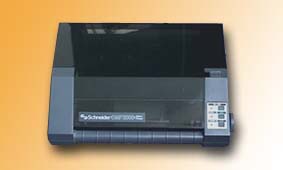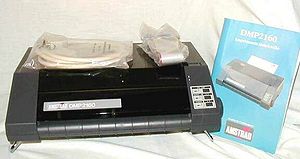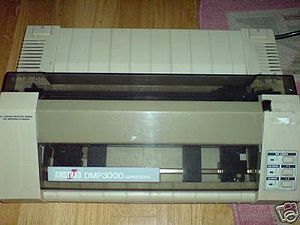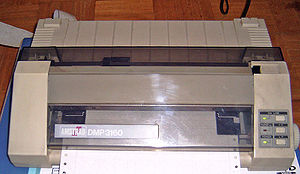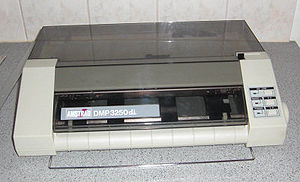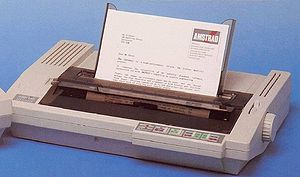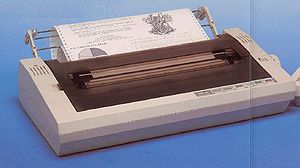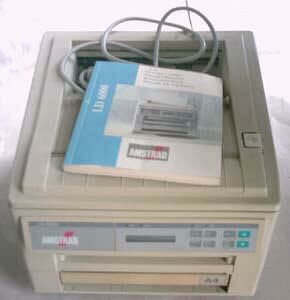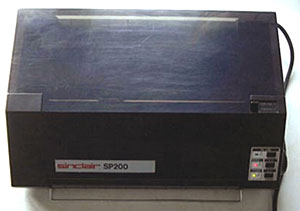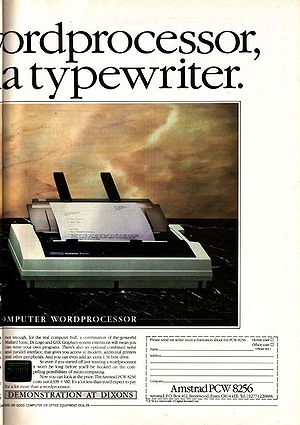- Amstrad/Schneider Printer Models
- Amstrad/Schneider Printer Technical Specifications
- Amstrad/Schneider Printer Control Codes
- Amstrad/Schneider Printer Support for 7bit Printer Ports
- Amstrad/Schneider Printer Character Sets
- Amstrad/Schneider Printer Buttons and DIP Switches
- Amstrad/Schneider Printer Resources (User and Service Manuals, Datasheets, ROM-images)
Amstrad/Schneider Printer Models
CPC Series
- DMP-1 (Amstrad) (Seikosha GP500) (1984) more info
- Early unihammer printer (with 7-dot columns)
- Very slow, with rather crude character set (without underlengths and without NLQ)
- Supports only 9 control codes (not compatible with Epsons or other standards)
- NLQ401 (Schneider) (Centronics Data Computer Corp.) (19xx) more info
- This is Schneider's counterpart to the Amstrad DMP1.
- The NLQ401 is a 9pin printer with NLQ und underlength support (thus much better than the DMP1). The NLQ character set is defined in very high horizontal resolution (even better than the NLQ sets in later DMP2000..DMP3000 models).
- Unlike DMP1 and DMP2000..3000, the NLQ401 doesn't include a SRAM chip (so data can be buffered only in a portion of the CPU's on-chip 256-byte RAM).
- Supports some custom control codes mixed with some Epson codes, but isn't actually Epson compatible (a couple of Epson codes are missing, and Epson graphics codes are crippled to 7bit).
- DMP2000 (Amstrad/Schneider) (Oct 1985) more info
- Epson FX-80 compatible 9-pin printer (with additional NLQ support, which wasn't supported on the original FX-80)
- Same hardware as DMP3000, but in CPC-style black case (see DMP3000 section for some extra differences)
- DMP2160 (Amstrad/Schneider) (19xx) more info
- Fast version of DMP2000 (prints 160 CPS, instead of 105 CPS)
- Firmware is nearly byte-identical to DMP2000 version (differences are some changed timing values, and a new waitloop that handles a new signal coming from Port C, Bit 4)
PC Series (gray)
- DMP3000 (Amstrad/Schneider) (19xx) more info
- Same hardware as DMP2000, with following differences:
- PC-style gray case (instead of the darker CPC coloured case)
- More RAM (8Kbyte; instead of 2Kbyte)
- More EPROM (8K+16K, or optionally 32K; instead of 16Kbyte)
- Additional IBM character set (instead plain 7bit Epson/ASCII charset)
- AutoLF signal supported (enabled via J4 jumper; instead of GNDing the AutoLF input)
- User manual addressed to PC users (instead of CPC/MSX/BBC/C64 users)
- and, maybe... additional italics support (DMP2000 doesn't explicitly mention italics support; though probably both DMP2000+3000 do support them)?
- DMP3160 (Amstrad/Schneider) (Sep 1987) more info
- Fast version of DMP3000 (prints 160 CPS, instead of 105 CPS)
- Contains a new mainboard that combines most of the TTL logic in a single SMD chip
- DMP3250di (Amstrad/Schneider) (19xx) more info
- Dual-interface version of DMP3160 (with centronics and rs232 ports)
- Like the DMP3160, it prints only 160 CPS (not 250 CPS)
- Slightly redesigned case (bigger transparent plastic lid, and metal stands moved from left/right to front/back side)
- Dated around 1990 (MJC Supplies started to offer DMP3250 ribbons in ACU Oct 1990)
- DMP4000 (Amstrad/Schneider) (Apr 1987) more info
- Extra big wide printer (paper width 16 inch)
- Said to be compatible with Epson FX-100 (the wide version of the Epson FX-80)
- LQ3500 (Nov 1987) and LQ3500di more info
- LQ3500di version with dual interface (centronics and rs232)
- Letter Quality 24pin Dot Matrix Printer
- LQ5000di more info
- Letter Quality 24pin Dot Matrix Printer, wide carriage (16 inch paper)
- With dual interface (centronics and rs232)
- LD6000 (Amstrad GmbH) (Sharp) more info
- Laser Printer (from Amstrad GmbH, for german market only)
- This is a rebadged Sharp printer that emulates an HP Laserjet II
Sinclair Series
- SP200 (Amstrad) (19xx) other pictures
- The official printer for Amstrad's Sinclair PC 200
- Seems to be a rebadged DMP2xxx or DMP3xxx printer
- Unknown if it contains a customized firmware version.
PCW Series (non-centronics)
PCWs were sold bundled with special printers, some with Dot Matrix printers, others with daisy wheel printers. The PCW printers aren't centronics compatible (most of the printer electronics is contained on the PCW computer mainboard, whilst the PCW printer contains only mechanics and low-level electronics).
- PCW8256 printer (see also)
- The printer that was bundled with the PCW8256



